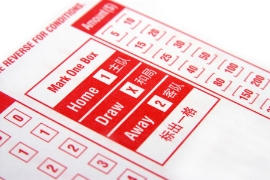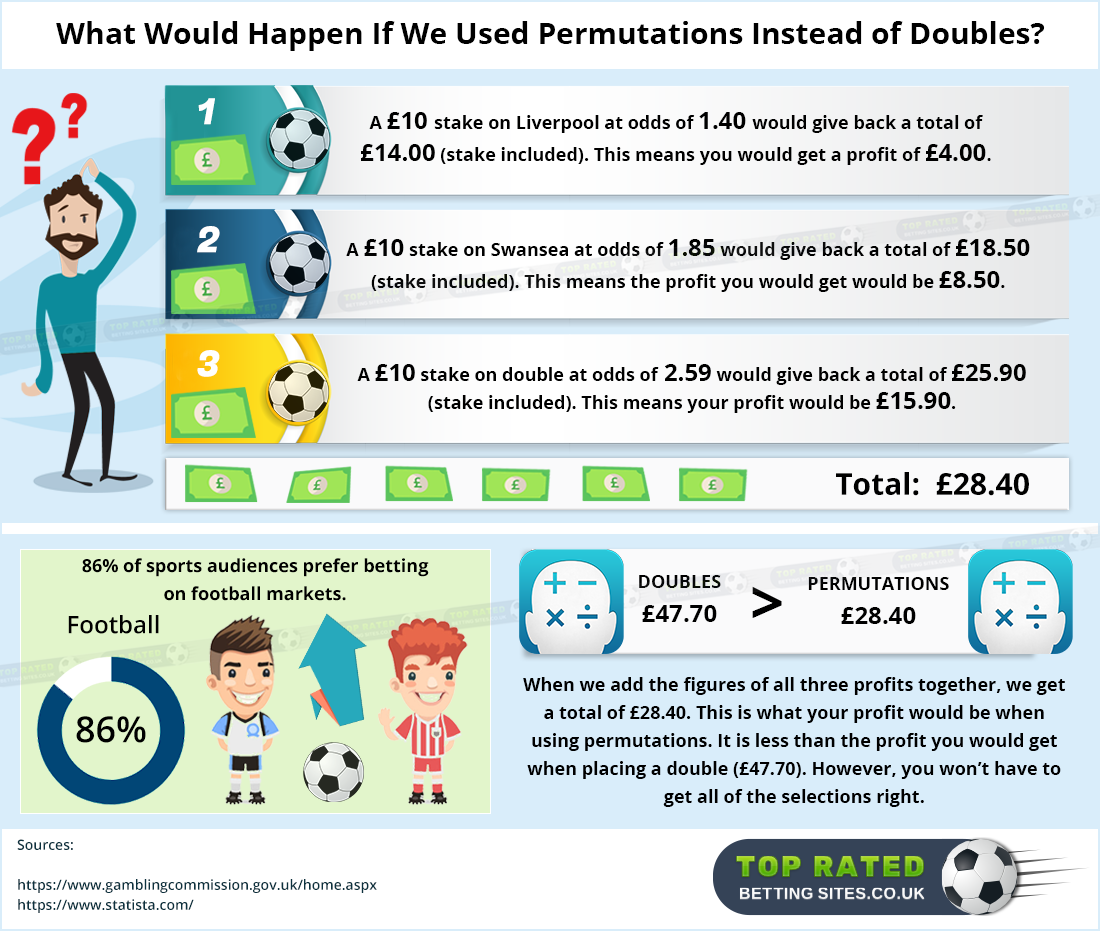Football Permutations Calculator
The Permutations Calculator finds the number of subsets that can be created including subsets of the same items in different orders. The PERMUT function calculates permutations where repetitions are not allowed. To calculate permutations where repetitions are allowed, use the PERMUTATIONA function.
- Football Permutations Calculator Online
- Football Permutations Calculator Chart
- Distinguished Permutation Calculator
- Combination And Permutation Calculator Soup
- Permutation Calculator Soup
Find out how many different ways to choose items.
For an in-depth explanation of the formulas please visit Combinations and Permutations.
Example has 1,a,b,c. Will allow if there is an a, or b, or c, or a and b, or a and c, or b and c, or all three. At the same time, Permutations Calculator can be used for a mathematical solution to this problem as provided below. The word 'CRICKET' has $7$ letters where $2$ are vowels (I, E). Vowels must come together. Therefore, group these vowels and consider it as a single letter.
Note: The old Flash version is here.
For an in-depth explanation please visit Combinations and Permutations.
Power Users!
You can now add 'Rules' that will reduce the List:The 'has' rule which says that certain items must be included (for the entry to be included).
Example: has 2,a,b,c means that an entry must have at least two of the letters a, b and c.
The 'no' rule which means that some items from the list must not occur together.
Example: no 2,a,b,c means that an entry must not have two or more of the letters a, b and c.
The 'pattern' rule is used to impose some kind of pattern to each entry.
Example: pattern c,* means that the letter c must be first (anything else can follow)
Put the rule on its own line:
Example: the 'has' rule
a,b,c,d,e,f,g
has 2,a,b
Combinations of a,b,c,d,e,f,g that have at least 2 of a,b or c
Rules In Detail
The 'has' Rule
The word 'has' followed by a space and a number. Then a comma and a list of items separated by commas.
The number says how many (minimum) from the list are needed for that result to be allowed.
Example has 1,a,b,c
Will allow if there is an a, or b, or c, or a and b, or a and c, or b and c, or all three a,b and c.
In other words, it insists there be an a or b or c in the result.
So {a,e,f} is accepted, but {d,e,f} is rejected.
Example has 2,a,b,c
Will allow if there is an a and b, or a and c, or b and c, or all three a,b and c.
In other words, it insists there be at least 2 of a or b or c in the result.
So {a,b,f} is accepted, but {a,e,f} is rejected.
The 'no' Rule
The word 'no' followed by a space and a number. Then a comma and a list of items separated by commas.
The number says how many (minimum) from the list are needed to be a rejection.
Example: n=5, r=3, Order=no, Replace=no
Which normally produces:
{a,b,c} {a,b,d} {a,b,e} {a,c,d} {a,c,e} {a,d,e} {b,c,d} {b,c,e} {b,d,e} {c,d,e}
But when we add a 'no' rule like this:
a,b,c,d,e,f,g
no 2,a,b
We get:
{a,c,d} {a,c,e} {a,d,e} {b,c,d} {b,c,e} {b,d,e} {c,d,e}
The entries {a,b,c}, {a,b,d} and {a,b,e} are missing because the rule says we can't have 2 from the list a,b (having an a or b is fine, but not together)
Example: no 2,a,b,c
Allows only these:
{a,d,e} {b,d,e} {c,d,e}
It has rejected any with a and b, or a and c, or b and c, or even all three a,b and c.
So {a,d,e) is allowed (only one out of a,b and c is in that)
Football Permutations Calculator Online
But {b,c,d} is rejected (it has 2 from the list a,b,c)
Football Permutations Calculator Chart

Example: no 3,a,b,c

Allows all of these:

{a,b,d} {a,b,e} {a,c,d} {a,c,e} {a,d,e} {b,c,d} {b,c,e} {b,d,e} {c,d,e}
Only {a,b,c} is missing because that is the only one that has 3 from the list a,b,c
The 'pattern' Rule
The word 'pattern' followed by a space and a list of items separated by commas.
You can include these 'special' items:
Distinguished Permutation Calculator
- ? (question mark) means any item. It is like a 'wildcard'.
- * (an asterisk) means any number of items (0, 1, or more). Like a 'super wildcard'.
Example: pattern ?,c,*,f

Means 'any item, followed by c, followed by zero or more items, then f'
So {a,c,d,f} is allowed
And {b,c,f,g} is also allowed (there are no items between c and f, which is OK)
But {c,d,e,f} is not, because there is no item before c.
Example: how many ways can Alex, Betty, Carol and John be lined up, with John after Alex.
Use: n=4, r=4, order=yes, replace=no.
The result is:
{Alex,Betty,Carol,John} {Alex,Betty,John,Carol} {Alex,Carol,Betty,John} {Alex,Carol,John,Betty} {Alex,John,Betty,Carol} {Alex,John,Carol,Betty} {Betty,Alex,Carol,John} {Betty,Alex,John,Carol} {Betty,Carol,Alex,John} {Carol,Alex,Betty,John} {Carol,Alex,John,Betty} {Carol,Betty,Alex,John}
While a big part of what I do with football data is predictive, I wanted something that neutrally describes what’s actually possible (and impossible).
Combination And Permutation Calculator Soup

I’ve written some code that runs through every possible combination of results from a given round of matches and works out what the league table would look like for each one. It then aggregates these to show what the highest and lowest positions attainable by each club are and how many ways there are of achieving each, to set some expectations around how much the table can change in a given week.
Because I’m interested in what’s genuinely possible (and impossible), I’ve ignored goal difference and just considered three possibilities for each match: home win, draw and away win. This is probably just as well, given that even having just those three possible outcomes for each of the 12 matches in one division represents 3^12 = 531,441 different combinations for my modestly-specced laptop to crunch through.
If I wanted to look at individual scorelines then the numbers quickly become obscene. Even if I only wanted to sim every possible result between 3-0 and 0-3, I’d be looking at a completely unmanageable 16^12 = 281,474,976,710,656 different combinations to simulate per division each weekend.
Permutation Calculator Soup
Here’s what a typical week’s graphic looks like:
The green blob is the highest position a club can possibly rise to and the red is the lowest they can sink for the round of matches in question. Grey blobs – both the small ones and the larger numbered ones – indicate a club’s current position.
The range of possible positions will start out wide at the beginning of a season, narrowing as time goes on and three points starts to represent an increasingly small percentage of the average club’s total. We should also see some patterns as clubs start to cluster into groups and gulfs start appearing in the table.